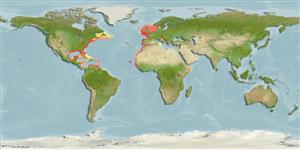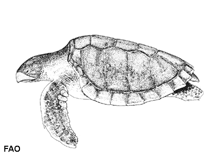Lepidochelys kempii (Garman, 1880)
Kemp's ridley turtle| Native range | All suitable habitat | Point map | Year 2050 |

|
| This map was computer-generated and has not yet been reviewed. |
| Lepidochelys kempii AquaMaps Data sources: GBIF OBIS |
Classification / Names Common names | Synonyms | CoL | ITIS | WoRMS
Not assigned | Testudines | Cheloniidae
Environment: milieu / climate zone / depth range / distribution range Ecology
Demersal. Tropical; 60°N - 9°N, 98°W - 17°E (Ref. 1397)
Distribution Countries | FAO areas | Ecosystems | Occurrences | Introductions
Atlantic Ocean and the Mediterranean (Malta).
Length at first maturity / Size / Weight / Age
Maturity: Lm 60.0 range ? - ? cm Max length : 74.8 cm CL male/unsexed; (Ref. 74991); 65.7 cm CL (female); common length : 65.6 cm CL male/unsexed; (Ref. 1397); max. published weight: 0.00 g
Short description Morphology
Body mass lower than 50,000 g. Carapace of adults are nearly round. Head: moderate-sized; subtriangular. Hatchlings: longer carapace and larger head. As it grows, carapace changes its shape and becomes a little wider. Head with 2 pairs of prefrontal scales. Carapace: with 5 central, 5 pairs of lateral and 12 pairs of marginal scutes; bridge areas have 4 scutes. Each with a pore which is the opening of the Rathke’s gland. This gland plays a pheromonal role in maintaining the integrity of the massed nesting assemblage of females just off the beaches in which it releases an odoriferous substance before and during their arrival. One visible claw on fore flippers; hatchlings show two, in rear flippers 1 or 2 claws. Color: in adults, plain olive-grey dorsally, white or yellowish underneath; in hatchlings, jet black when wet; changes significantly with age; after 10 months, plastron is nearly white.
One of the smallest of the sea turtles. Usually inhabits sandy and muddy bottoms that are rich in crustaceans. A carnivorous species mostly feeds on crustaceans, mollusks, fishes and vegetable fragments. Mating season occurs from April to the end of July. Females are occasionally escorted or seen mating at the near surf area. This turtle are known to be day-time nesters and mass nesting takes place on windy days. The females lay eggs from 1.4 to 1.55 times each season with a number of 102 eggs per clutch. Incubation period lasts for 45 to 58 days depending on temperature and humidity. Commercial exploitation of this species is not allowed throughout its distribution range (Ref. 1397). Usually inhabits sandy and muddy bottoms that are rich in crustaceans (Ref. 1397). A carnivorous species that mostly feeds on crustaceans, mollusks, fishes, vegetable fragments and so on.
Life cycle and mating behavior Maturity | Reproduction | Spawning | Eggs | Fecundity | Larvae
Mating season occurs from April to the end of July. Females are occasionally escorted or seen mating at the near surf area. This turtle are known to be day-time nesters and mass nestings takes place on windy days. The females lay eggs from 1.4 to 1.55 times each season with a number of 102 eggs per clutch. Eggs looks like ping-pong balls with size ranging between 3.4 and 4.5 cm; and weigh from 24 to 40 g. Incubation period lasts for 45 to 58 days depending on temperature and humidity (Ref. 1397). Temperature-dependent Sex Determination (TSD) is demonstrated in this species (Ref. 83971).
Main reference
References | Coordinator | Collaborators
Hirth, H.F. 1993. (Ref. 97534)
IUCN Red List Status (Ref. 130435)
Critically Endangered (CR) (A2bd); Date assessed: 14 January 2019
CITES status (Ref. 108899)
Appendix I: International trade banned
CMS (Ref. 116361)
Appendix I & II: Endangered migratory species conserved through agreements
Threat to humans
Human uses
Fisheries: commercial
| FishSource | Sea Around Us
Tools
More information
Internet sources
BHL | BOLD Systems | CISTI | DiscoverLife | FAO(Publication : search) | Fishipedia | GenBank (genome, nucleotide) | GloBI | Gomexsi | Google Books | Google Scholar | Google | PubMed | Tree of Life | Wikipedia (Go, Search) | Zoological Record
Estimates based on models
Preferred temperature
(Ref. 115969): 18.3 - 27.3, mean 24.2 (based on 614 cells).
Resilience
(Ref. 69278):
High, minimum population doubling time less than 15 months (K=0.13-1.3; tm=9.5).
Price category
(Ref. 80766):
Unknown.



